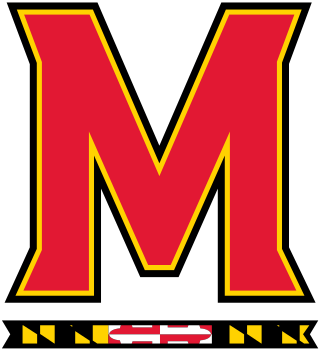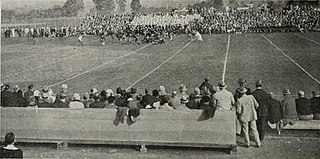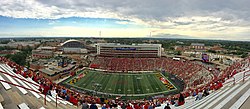
M&T Bank Stadium is a multi-purpose football stadium located in Baltimore, Maryland. It is the home of the Baltimore Ravens of the National Football League (NFL). The stadium is immediately adjacent to Oriole Park at Camden Yards, the home of the Baltimore Orioles. Often referred to as "Ravens Stadium" or "The Bank", M&T Bank Stadium officially opened in 1998 and has been praised for its fan amenities, ease of access, concessions and other facilities. The listed capacity for M&T Bank Stadium is 70,745.

Rice–Eccles Stadium is an outdoor college football stadium located on the campus of the University of Utah in Salt Lake City, Utah. It is the home field of the Utah Utes of the Pac-12 Conference. It served as the main stadium for the 2002 Winter Olympics; the Opening and Closing Ceremonies were held at the stadium, which was temporarily renamed "Rice–Eccles Olympic Stadium".

The Jones-Hill House is an indoor collegiate sports training complex located on 14.5 acres (5.9 ha) of land on the campus of the University of Maryland in College Park, a suburb north of Washington, D.C. Jones-Hill House is situated in the center of the campus, adjacent to Capital One Field at Maryland Stadium, near Stamp Student Union and McKeldin Library. The building was constructed between 1952 and 1955 at a cost of $3.3 million and served for nearly 50 years as the home court of the Maryland Terrapins men's and women's basketball teams. A multi-phase, $196 million renovation commenced in 2015 to transform the capacity 14,956-seat basketball arena into a 356,000-square-foot (33,100 m2) sports and academic complex that includes an indoor practice facility and operations center for the university's football program, a sports science and sports medical research center, and an incubator for entrepreneurs. The facility was formerly named the William P. Cole Jr. Student Activities Building, commonly known as Cole Field House. In April 2021, the facility was renamed in honor of Billy Jones and Darryl Hill, the first Black men to integrate basketball and football at Maryland, respectively.

Darrell K Royal Memorial Stadium, located in Austin, Texas, on the campus of the University of Texas, has been home to the Longhorns football team since 1924. The stadium has delivered a home field advantage with the team's home record through November 17, 2018 being 375–117–10 (.764). The official stadium seating capacity is 100,119, making the stadium the largest in the Big 12 Conference, the seventh largest stadium in the United States, and the ninth largest stadium in the world.

Memorial Stadium is a stadium in Bloomington, Indiana, United States. It is primarily used for football, and has been the home of Indiana Hoosiers football since its opening in 1960. It is the tenth largest stadium in the Big Ten Conference, with a capacity of 52,626. The field has a conventional north-south alignment, at an approximate elevation of 771 feet (235 m) above sea level.

Veterans Memorial Stadium at Larry Blakeney Field is a stadium in Troy, Alabama. It is primarily used for American football, and is the home field of the Troy University Trojans. The seating capacity is 30,470. The stadium was originally built in 1950, and has regularly been expanded, renovated and improved since then. The stadium was named in honor of the college students and local residents who gave their lives during World War II. The field received its name from retired head coach Larry Blakeney, the coach with the most wins in Troy history.

MM Roberts Stadium, also known as "The Rock", is an American football stadium located in Hattiesburg, Mississippi. It is the home of The University of Southern Mississippi Golden Eagles football team.

Valley Children's Stadium, also known as Jim Sweeney Field at Bulldog Stadium, is an outdoor college football stadium in the western United States, located on the campus of California State University, Fresno in Fresno, California. It is the home field of the Fresno State Bulldogs, who play in the Mountain West Conference.

Vaught–Hemingway Stadium at Hollingsworth Field is an outdoor athletic stadium located in University, Mississippi, United States. The stadium serves as the home for the University of Mississippi Rebels college football team. The stadium is named after Johnny Vaught and Judge William Hemingway. Since its expansion in 2016, it is the largest stadium in the state of Mississippi with a capacity of 64,038 and also holds the state record for attendance at 66,703.

Johnny Unitas Stadium is a multi-purpose sports stadium in Towson, Maryland, United States. The home of several Towson University athletics teams, it is also known as Minnegan Field at Johnny Unitas Stadium or Unitas Stadium.

Plaster Stadium is a 17,500-seat football stadium located in Springfield, Missouri. It is home to the Missouri State Bears football team.

Burgess–Snow Field at JSU Stadium is a 24,000-seat multi-purpose stadium in Jacksonville, Alabama. It opened in 1947 and is home to the Jacksonville State Gamecocks football team. It was also home to the Jacksonville High School Golden Eagles football team until 2004, when they moved to a new stadium on the high school campus. It also served as home to Jacksonville Christian Academy's football team from 2005 until September 27, 2007, when JCA opened an on campus football field.

Kidd Brewer Stadium is a 30,000-seat multi-purpose stadium located in Boone, North Carolina. Nicknamed "The Rock," the stadium is the home of the Appalachian State Mountaineers football team. Kidd Brewer stands 3,333 feet (1,016 m) above sea level. The Mountaineers boast a 263–77–5 (.770) home record at the stadium.

The Maryland Terrapins football team represents the University of Maryland, College Park in the sport of American football. The Terrapins compete in the NCAA Division I Football Bowl Subdivision (FBS) and the Big Ten Conference. The Terrapins joined the Big Ten Conference on July 1, 2014, following 62 years in the Atlantic Coast Conference as a founding member. Mike Locksley is the head coach of the Terrapins.

Joan C. Edwards Stadium, formerly Marshall University Stadium, is a football stadium located on the campus of Marshall University in Huntington, West Virginia, United States. It currently can hold 30,475 spectators and includes twenty deluxe, indoor suites, 300 wheelchair-accessible seating, a state-of-the-art press-box, 14 concession areas, and 16 separate restrooms. It also features 90,000 sq ft (8,000 m2) of artificial turf and 1,837 tons of structural steel. It also houses the Shewey Athletic Center, a fieldhouse and a training facility. The new stadium opened in 1991 and replaced Fairfield Stadium, a condemned off-campus facility built in 1927 in the Fairfield Park neighborhood.

The Crab Bowl Classic is the name given to the Maryland–Navy football rivalry. It is an American college football rivalry between the Maryland Terrapins football team of the University of Maryland and the Navy Midshipmen football team of the United States Naval Academy. The two institutions, located in close proximity in the state of Maryland, first met for a football game in 1905. Since then, the series has often been marked by controversy, with incidents by players and supporters occurring both on and off the field. The winner of the game is awarded the Crab Bowl Trophy.

Old Byrd Stadium, also known as Byrd Stadium or Byrd Field and nicknamed "the Byrd Cage", was the home stadium for the University of Maryland from 1923 until 1947. It was located in College Park, Maryland, east of Baltimore Avenue on the site of the school's present-day fraternity row. The seating capacity for the stadium was 5,000.
The Maryland Terrapins baseball team is the varsity intercollegiate baseball program of University of Maryland, College Park in College Park, Maryland, United States. The program's first season was in 1893, and it has been a member of the NCAA Division I Big Ten Conference since the start of the 2015 season. Its home venue is Shipley Field at Bob "Turtle" Smith Stadium, located on Maryland's campus. Matt Swope is the team's head coach starting in the 2024 season. The program has appeared in six NCAA tournaments. It has won one conference tournament championship and five regular season conference titles. As of the start of the 2021 Major League Baseball season, 38 former Terrapins have appeared in Major League Baseball.

McColl–Richardson Field at Jerry Richardson Stadium is a college football stadium in University City, Charlotte, North Carolina, United States and the home field of the Charlotte 49ers football team representing the University of North Carolina at Charlotte. The team became a Football Bowl Subdivision member in 2015 and competes in The American Athletic Conference.

The 2023 Maryland Terrapins football team represents the University of Maryland in the East Division of the Big Ten Conference during the 2023 NCAA Division I FBS football season. The Terrapins are led by Mike Locksley in his fifth year as head coach. They play their home games at SECU Stadium in College Park, Maryland.































